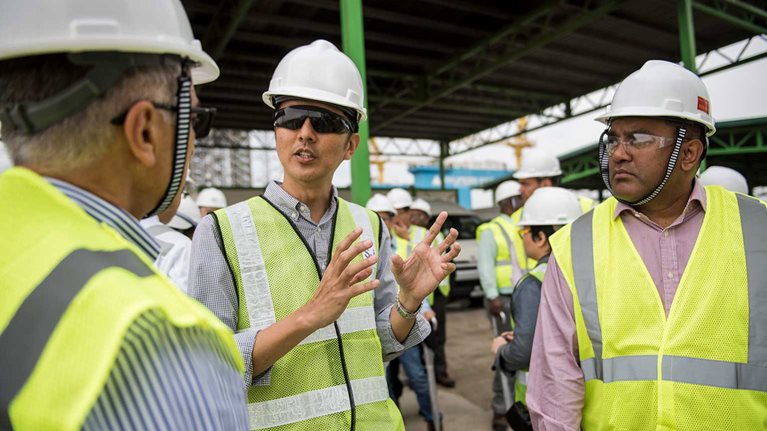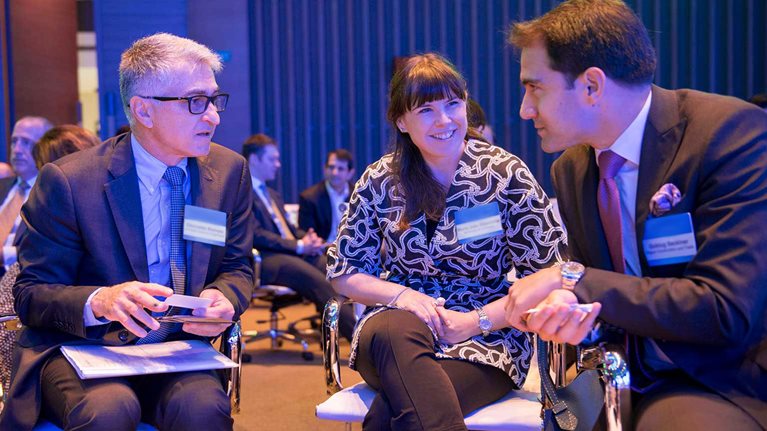Sweden is experimenting with an “e-Highway” for large-scale freight trucks, a combination of electrified rail and overhead cables. The goal is to eliminate reliance on fossil-fuel vehicles by 2030.
In China, 90 percent of a skyscraper can be built in the controlled environment of a factory—and at the end of its life, almost completely be recycled.
In an industry that has its share of false starts and struggling projects, amazing things are happening—and learning from the best is one of the principles behind our Global Infrastructure Initiative (GII).
GII brings together stakeholders from across the industry through a series of initiatives: a global summit, regional roundtables, innovation site visits and a quarterly publication. The overall goals are to share the best new ideas, pool expertise, and solve the industry’s structural issues, all with an eye to tangibly improving the way we deliver essential infrastructure and squeezing more out of our existing assets.
This week, GII announced that London will be the host city for its fifth global summit next year: October 29 to 31. GII is convened by our Capital Projects & Infrastructure (CP&I) Practice, which has nearly 500 consultants, engineers, developers, and experts helping clients plan, finance, deliver, and operate infrastructure and large capital projects worldwide. On the fifth anniversary of GII, we caught up with two of its leaders, Rob Palter and Tony Hansen.

The idea for GII arose when the Infrastructure Practice first began. At the time, there were numerous events. “But most of them focused on a specific type of infrastructure–such as airports, roads, or ports–or a function such as finance or construction–or were regional in nature,” recalls Rob Palter, global coleader of the CP&I Practice. “There was no place where the entire industry could get together in a solutions-focused conversation.” So Palter and his team set out to create an event that would do this.
The inaugural summit took place in 2012 at the Çırağan Palace in Istanbul. It soon became clear that there was a strong appetite for ongoing conversations and collective brainstorming—prompting Palter’s team to grow GII from a one-off summit to the continuous, year-round cycle of engagement. Regional roundtables focused on local issues, such as affordable housing in San Francisco, and innovation site visits were planned to “best in class” projects. These include the upcoming excursions to King Abdullah Economic City in Saudi Arabia, which has been master-planned from the desert up, and Hyperloop One in Las Vegas, Nevada, an electric, autonomous pod-and-tube transportation system with the potential to move people at 700 miles per hour. In addition, themed insights are published in our quarterly publication, Voices on Infrastructure.

While the GII digital community has grown to more than 5,000 leaders, the summit attendance has been limited to under 200 participants. According to GII director Tony Hansen, this allows a high level of interaction and gives each participant a voice. The agenda blends plenary panel discussions, pitches for inspiring ideas, and small breakouts for hands-on, collaborative sessions about real projects.
While networking and brainstorming are critical, the greater aspiration is for GII to improve the overall performance of infrastructure and move the industry forward. “At the Istanbul summit, many participants were reluctant to embrace the potential of technology,” says Hansen. “Just five years later, the role of technology and digital analytics in helping companies optimize assets is a priority for the industry. We encouraged this shift by making innovation a central part of our 2015 summit in San Francisco, our 2017 summit in Singapore, and our innovation site visit to GE Digital headquarters.” Digital transformation will continue to feature prominently in the 2018 Summit agenda.
“Construction is one of the last industries to embrace new technologies,” explains Palter. “While there are a lot of ‘shiny objects’ on the market, such as drones and augmented reality, there is no pragmatic road map on how to actually implement these technologies, how much investment is required, what sort of talent to hire, what value is at stake.”
Another concern is the successful execution of large infrastructure programs, such as Crossrail (pictured at top), an underground tunnel linking the four economic hubs of London, and Asia’s Belt and Road Initiative (BRI) which aims to create economic, physical, and maritime corridors connecting China to most of Africa, Asia, Europe, and the Middle East.
Conceptually, Palter says, the value is clear; yet the complexity of BRI, which involves more than 20 countries, makes it a Herculean effort despite widespread buy-in. “It’s not about managing single projects—but entire systems—whether a citywide water system, a bridge and tunnel structure, or transnational corridor—how do we bring these megaprojects in under budget and on time? It will take everyone’s best thinking.”